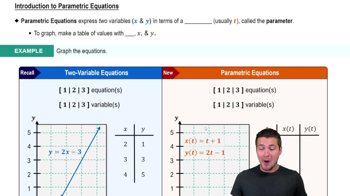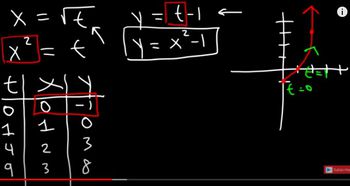Table of contents
- 0. Review of College Algebra4h 43m
- 1. Measuring Angles39m
- 2. Trigonometric Functions on Right Triangles2h 5m
- 3. Unit Circle1h 19m
- 4. Graphing Trigonometric Functions1h 19m
- 5. Inverse Trigonometric Functions and Basic Trigonometric Equations1h 41m
- 6. Trigonometric Identities and More Equations2h 34m
- 7. Non-Right Triangles1h 38m
- 8. Vectors2h 25m
- 9. Polar Equations2h 5m
- 10. Parametric Equations1h 6m
- 11. Graphing Complex Numbers1h 7m
10. Parametric Equations
Graphing Parametric Equations
Problem 8.30
Textbook Question
Graph each plane curve defined by the parametric equations for t in [0, 2π] Then find a rectangular equation for the plane curve. See Example 3.
x = 2 cos t , y = 2 sin t
 Verified step by step guidance
Verified step by step guidance1
Step 1: Recognize that the given parametric equations x = 2 \cos t and y = 2 \sin t represent a circle in the parametric form. The parameter t varies from 0 to 2\pi, which is a full rotation around the circle.
Step 2: To graph the plane curve, plot points for various values of t within the interval [0, 2\pi]. For example, calculate (x, y) for t = 0, \frac{\pi}{2}, \pi, \frac{3\pi}{2}, and 2\pi. These points will help you sketch the circle.
Step 3: Notice that the parametric equations are similar to the standard form of a circle x = r \cos t and y = r \sin t, where r is the radius. Here, r = 2, indicating a circle with radius 2 centered at the origin.
Step 4: To find the rectangular equation, use the Pythagorean identity \cos^2 t + \sin^2 t = 1. Substitute x = 2 \cos t and y = 2 \sin t into this identity to eliminate the parameter t.
Step 5: Solve for the rectangular equation by substituting: \left(\frac{x}{2}\right)^2 + \left(\frac{y}{2}\right)^2 = 1, which simplifies to x^2 + y^2 = 4. This is the equation of a circle with radius 2 centered at the origin.
Recommended similar problem, with video answer:
 Verified Solution
Verified SolutionThis video solution was recommended by our tutors as helpful for the problem above
Video duration:
3mPlay a video:
Was this helpful?
Key Concepts
Here are the essential concepts you must grasp in order to answer the question correctly.
Parametric Equations
Parametric equations express the coordinates of points on a curve as functions of a variable, typically denoted as 't'. In this case, x and y are defined in terms of the parameter t, allowing for the representation of curves that may not be easily described by a single equation. Understanding how to manipulate and interpret these equations is crucial for graphing the curve.
Recommended video:

Parameterizing Equations
Graphing Parametric Curves
Graphing parametric curves involves plotting points defined by the parametric equations over a specified range of the parameter. For the given equations x = 2 cos t and y = 2 sin t, as t varies from 0 to 2π, the points trace out a circle. Familiarity with the unit circle and the behavior of sine and cosine functions aids in visualizing the resulting graph.
Recommended video:

Introduction to Parametric Equations
Rectangular Equation
A rectangular equation eliminates the parameter by expressing the relationship between x and y directly. For the given parametric equations, using the identities cos²(t) + sin²(t) = 1 allows us to derive the rectangular equation x² + y² = 4. This transformation is essential for understanding the geometric properties of the curve in Cartesian coordinates.
Recommended video:

Convert Equations from Rectangular to Polar

 4:47m
4:47mWatch next
Master Introduction to Parametric Equations with a bite sized video explanation from Patrick Ford
Start learning




